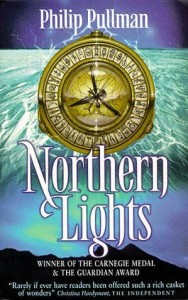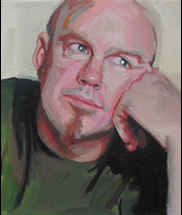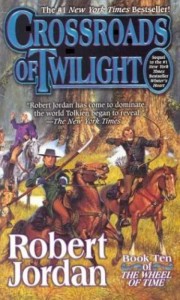 I’m thrilled to introduce today’s guest, the one and only Orson Scott Card. Orson Scott Card is most well-known as the author of the award-winning novel Ender’s Game, published in 1985. Ender’s Game won both the Nebula and the Hugo awards. And no wonder that was so popular–I just finished reading it for the first time and I found it be compelling throughout.
I’m thrilled to introduce today’s guest, the one and only Orson Scott Card. Orson Scott Card is most well-known as the author of the award-winning novel Ender’s Game, published in 1985. Ender’s Game won both the Nebula and the Hugo awards. And no wonder that was so popular–I just finished reading it for the first time and I found it be compelling throughout.
He has written many stories in the genres of science fiction, fantasy, and Biblical. And he’s contributed to the publishing business in other ways besides writing. He is the founder of professional speculative fiction magazine Orson Scott Card’s Intergalactic Medicine Show, which has published some amazing stories. He also runs a yearly weeklong writer’s workshop titled Literary Boot Camp. Entry to the workshop is application-based and very competitive. Graduation from Boot Camp would be a great addition to any cover letter. Check out his website Hatrack River, and while you’re there stop by the Hatrack River Writer’s Workshop, a writer’s forum where you can ask for advice, share commiserations and congratulations, and just generally shoot the breeze.
David Steffen: At what point did you decide you wanted to be a writer?
Orson Scott Card: I’m not sure I ever really did. Writing was ‘in the air’ in my house – my dad subscribed to Writer’s Digest, and as Mormons it was part of our culture to write sermons, essays, and even comic plays. So I always wrote and thought of writing as something regular people did all the time. But it wasn’t a career choice! I entered college as an archaeology major, but found I was spending all my time in the theatre department. So I changed majors. I started writing in order to fix plays (Flowers for Algernon, for instance, had a terrible second act, so with the director’s permission I wrote a new one based on the story and novel), and then to adapt novels for readers’ theatre productions. Then I started writing one-act plays for a playwriting class, and finally wrote a full-length play, which was produced by a faculty member. Later came mainstage plays at the university and elsewhere, and there were sold-out houses and held-over runs. So I began to think of myself as a playwright – though I was also a director and actor and singer.
Later, as a theatre company I started was failing (a relative term – our deficits, without subsidy of any kind, were remarkably low!), I needed to earn extra money. So I turned seriously to writing short stories as the only way I could think of to earn a buck. After that decision, my first story was “Ender’s Game.” Some of my earlier, hobby-period stories became “The Worthing Saga,” and I was off and running. Even then, I still earned more than half my income as a freelance editor and as an audio scriptwriter; I didn’t really think of myself as mainly a fiction writer until I started earning serious money at the gig. And in my heart, I still think I’m a better play director than writer. But I can’t get paid for it!
David: Where did the idea for the original Ender’s Game novelette originate?
OSC: In 1968, my brother was in the army. He was stationed at Ft. Douglas in Salt Lake City, and so he came home most weekends, where he met the woman he eventually married. For my birthday in 1968, he and his fiancee gave me the Foundation Trilogy, the first sci-fi novel I’d read since I read some Norton and Heinlein in junior high (I was not a dedicated fan, sci-fi was just one of the many genres I read in).
After reading Asimov – that brilliant, absolutely clear style! those sweeping stories! – I thought that I would like to be able to think of a great science fiction story idea. with my brother’s military experience looming in my mind, I thought: How would you train soldiers for war in space? I remembered Nordhoff & Hall’s novel about WWI aviators, and the problem the new pilots had with thinking in three dimensions (the enemy that killed them usually came from above or below, and they never saw him). It would be even worse in space, where there is no “down.” And if you just train out in space, you run the serious risk of having injured soldiers drift away. So I thought of the battle room, a football-field size cube in which trainees would get used to having to face opponents in three dimensions with a flexible up-and-down orientation. Sometimes there would be obstacles, sometimes not. And there the idea stayed for several years, while I worked on the Zenna Henderson-influenced Worthing stories from time to time.
Later, needing money, I took a notebook with me while accompanying a girlfriend as she took her boss’s kids to the circus. No ticket for me (which was fine, I am deeply bored by circuses); I sat on the lawn outside the Salt Palace in Salt Lake City and wrote, “Remember, the enemy’s gate is down.” The key new insight was: what if the trainees were children young enough that they could still absorb the three-dimensional, no-down space and make it, not second nature, but their FIRST nature? So Ender became a kid, the youngest commander in the history of Battle School, and then I just winged it from there.
David: I’ve heard that Ender’s Game is in the works to become a video game. What was your level of involvement of the design of the game? Is there anything about video game adaptations that surprised you?
OSC: The videogame is a problem, because there’s been no movie. Everybody wants to do the game of the movie – but that’s the game I DON’T want. I want to have games with replayability, not games where you just act out Ender and then you’re done with it. I want battle-room games, and battle-SCHOOL MUDDs, and games based on the formic wars, all three of them, and a version of the Mind Game from the books, and games about colonizing the former Formic worlds with all the surprises lurking there. The trick is to find someone willing to finance the development of these games. But this is the ONLY way to make it a franchise. My model is the way LucasArts developed and keeps renewing the Star Wars game franchise. I won’t settle for anything less. So I have detached the movie rights from the game rights – I learned my lesson with Warner, which was full of talk about developing the game regardless of what happened with the movie – all empty promises! Eventually, I’ll find a game publisher that doesn’t want to fire me and then make the game of the movie. Meanwhile, I have several brilliant game DESIGNERS, like the great team headed by Donald Mustard, who want to work with me on the game. But they don’t have the funding. It’s a matter of time!
David: You’ve also written for comic books. Did you find it difficult to adapt your writing to apply it to visual mediums?
OSC: Fortunately, I don’t have to be the artist – I don’t have to conceive the actual pictures. Essentially, writing a comic book IS writing a play. I write the panels and tell what should happen in the panels – but the artists will conceive the “shot” and find ways to make things clear. So I’m on very familiar turf. That doesn’t mean there weren’t things I had to learn – for instance, I had a scene in Ultimate Iron Man where someone pulls their hands out of manacles, cutting off fingers in the process. My brilliant editor (Nick Lowe) said, No, it’s unbearable to do that: it’s not like a movie, where the image flashes past you on the screen. It sits there on the page for the reader to STUDY. A great perception that I simply hadn’t grasped. So I definitely needed guidance, and I got better as I went along. Now I’m writing the first series of Formic Wars comics for Marvel – set before Ender’s Game – and I feel comfortable doing it.
David: What projects would you like to see yourself working on ten years from now?
OSC: I hope all my existing contracts and projects are long since fulfilled, and I get to spend my old age writing whatever I feel like, and not having to sell it until it’s written!
David: Looking back on the first five years of Intergalactic Medicine Show, did you go as you expected? What lessons have you learned through the launch?
OSC: Have we been doing it five years now? I didn’t think it was THAT long. No, it hasn’t gone as I’d hoped in the sense that we’re not finding as many readers as I wanted, and we’re still running at a loss. At the same time, the readers who DO buy and read the magazine really care about and enjoy the fiction, and it’s a joy to see the stories come to life. We buy illustrations for every story, so that the old-time magazine feel is still there, still alive in IGMS. And the readership is steadily growing, so someday I expect it will move from money-losing hobby to money-making institution! Ed Schubert does an excellent job as editor, and our pre-readers do a great job of letting the good submissions rise to the top. Kathleen Bellamy is managing editor but also art director, and she has assembled a wonderful array of artists who are willing to sacrifice to do excellent work for our pathetically low payment.
David: If you could give only one piece of advice to aspiring writers, what would it be?
OSC: The main advice is: Stop looking for advice and just keep putting words on paper. You learn more from writing a 100,000-word novel than from any number of classes or books on writing or workshops you might take (and I include mine in that – why bother going to a workshop if you’re not actually WRITING and FINISHING things?).
Having said that, my next most important advice is: Writer’s block is your friend. It is your unconscious mind telling you that something you just wrote, or are about to write, is not working. Either you don’t believe in it or you don’t care about the story any more. Your unconscious is your best editor – it tries desperately to keep you from writing crap. So the answer is NEVER to tough it out and force yourself to move on through your outline. The result of that will be garbage that you don’t care about and the reader won’t either. Instead, go back and change or amplify or add to the what-happens-and-why of the story (the “plain tale”); pick up on a minor character and make them somebody and see what they do; give an existing character a more complicated set of motives; change the way the world works in some significant way. Then go back to where that change starts happening and write everything from there on as if the previous version never existed. Don’t look at it, don’t think about the old version. Just write the NEW story, the one that has freshened in your mind.
The danger of this is that you end up writing seven-book trilogies – but worse things can happen! Some of the very best stuff in my writing has been a gift of writer’s block, which caused me to reinvent the story.
Fiddling with language or tiny meaningless details, of course, accomplishes nothing except to kill the spontaneity of the first draft. The first draft is the best draft – you only change spots where it isn’t clear or where the story isn’t working; you never just fiddle with language. That just kills your natural style.
Oh, and a last piece of advice: Even if Strunk and White’s Elements of Style were not a bunch of meaningless drivel and hideously bad advice for ALL writers, it certainly is meaningless for fiction writers! There is no virtue to eliminating “needless” words in fiction – and if you’re thinking about style, your style will be dead. You think about story and character, what happens and why, and let your natural voice carry the story. You’ll have an inimitable style then – your real voice – and the rules from the ignorant, miseducated English teachers who abused your understanding of the language throughout your miseducation will fall by the wayside, where they should be left behind. You can’t be thinking about language while you write; that’s like trying to ride a bicycle while thinking about balance and pedaling. And you’ve seen the stories that result from that kind of writing – a “style” that calls attention to itself constantly, so you can barely find the story through the English-professor-pleasing nonsense that has been smeared on the lens.
David: Where did the name for your website Hatrack River come from?
OSC: Hatrack River is a town in the Alvin Maker series – the birthplace of Alvin (as his pioneer parents were passing through) and the place where he served his apprenticeship.
David: What was the last book you read?
OSC: The last fiction book was The Broken Teaglass, by Emily Arsenault. The last BOOK was If Ignorance Is Bliss, Why Aren’t There More Happy People?: Smart Quotes for Dumb Times, by editors John Lloyd & John Mitchinson. Plus on my Kindle I’m nearing the end of a reread of Jane Austen’s Emma, and on my Nano I’m in the second half of Ken Scholes’s Canticle. Life is only happy when I have three or four books going at once.
David: Your favorite book?
OSC: For me, it’s a tie between Pride and Prejudice and Lord of the Rings. Those are the two books I most often reread.
David: Who is your favorite author?
OSC: The good writer whose book I am presently reading, because that’s the one I’m conversing with at the moment. There are so many writers whose work I love and/or admire that I can’t pick just one favorite – it would change every few weeks anyway!
Having said that – and it’s true – Austen and Tolkien are beloved favorites, as is Asimov; there’s a whole group of mystery writers whose work I avidly devour; I just discovered Thackeray and Trollope and am an enthusiastic new convert; and there are some extraordinary YA writers, the best of whom may well be Neal Shusterman, and the best of whose books (so far) is the absolutely brilliant, devastating Everlost. In sci-fi and fantasy, Ken Scholes, Patrick Rothfuss, Sherwood Smith, Robin Hobb, James Maxey, David Farland (but my favorites are the books he wrote as Dave Wolverton), and … and … I’m just going to leave out too many writers whose work I love, so I’ll stop.
David: What was the last movie you saw?
OSC: Me and Orson Welles. It was so brilliant I went back right away, this time with my wife and daughter, and saw it again. A great script, great directing, and above all absolutely brilliant acting, especially by Christian McKay in the title role – though all the other actors do a splendid job as well.
David: What is your favorite movie?
OSC: A Man for All Seasons – as close to a perfect movie as you can get. But I also love Far from the Madding Crowd and A Lion in Winter; and Sense and Sensibility (the Emma Thompson version) and Love Actually are also movies I frequently watch again. For the moment, call those my top five.
David: When is the next story set in the Enderverse going to come out? How about non-Ender related stories?
OSC: My next Ender-related work will be the Marvel comic series set during the Formic Wars. Outside of the Ender universe, I’m completing a novel called Pathfinder, which is ostensibly a YA novel but I’m just writing the way I usually do. And my Mithermages series is the next book I’m doing for TOR. Both are in progress at this moment.
David: Can you tell us about your works in progress?
OSC: Pathfinder is in a world colonized by the first human-built starship that attempted to do a time-space jump to cut down the length of interstellar voyages. In the time-jump it was divided into 19 copies, containing every single person and item (in addition to the original, which then went BACKWARD in time occupying the same space as the original ship on its voyage out to the jump-point). The copies of the colony ship also jumped more than 11,000 years backward in time – basically, the same amount of time since humans discovered agriculture and began to build cities.
So it becomes an opportunity for an experiment. all 19 colony ships land, each in a large enclave surrounded by a forcefield so there can be no mixing of populations. Technology is deliberately hidden so it has to be developed anew, and starting with the identical gene pool, every colony has eleven thousand years in which to develop their own civilizations – and their own genetic differences – before they catch up to the “present” of the ship’s original jump through spacetime.
At that point (well into the second volume, I might add), humans on Earth, having learned from what happened to the first jumpship, have perfected faster-than-light travel, and send out another ship some fifteen years after the first – but without the time-jump and the copying. That ship will arrive and find humanity much altered – in 19 different ways! – and, when they see what these people have become, they have the power and, perhaps, the will to destroy some or all of them and let new colonists take over. After all, the people of this new world are no long “human” – genetically or socially.
All of this is background – the skeleton on which the actual story hangs. The story begins entirely within one of the enclaves (each about the land area of Europe west of Russia), and only gradually, as we move through the story, do we step through the walls from one enclave to another. In a way, it has echoes of my novel Treason – another set of stranded colonists who, in isolation, developed differently – but the story is very, very different. I love the characters I’m working with and the world they’re moving through – it’s as much fun as writing Alvin Maker novels.
Mithermages is a completely unrelated fantasy series, but it ties to two stories already released: Stonefather and Sandmagic. In our contemporary world, the old gods are still around – but having been cut off from their home world a couple of thousand years before, their powers are much diminished and they live pretty much in disguise, out of place in a machine-using society. Our hero in this story is the first person in many centuries to have the ability to create new gates between the worlds – and some of the families are determined to kill him. So the series moves back and forth between two planets – with the looming menace of a third, the one that is the source of the gods and angels of the Bible and the Koran. I think this one will pretty much offend everybody, but it’s a great magical universe and I love these characters, too.
David: Orson, thanks so much for stopping by, and good luck with your writing!
http://www.hatrack.com/






